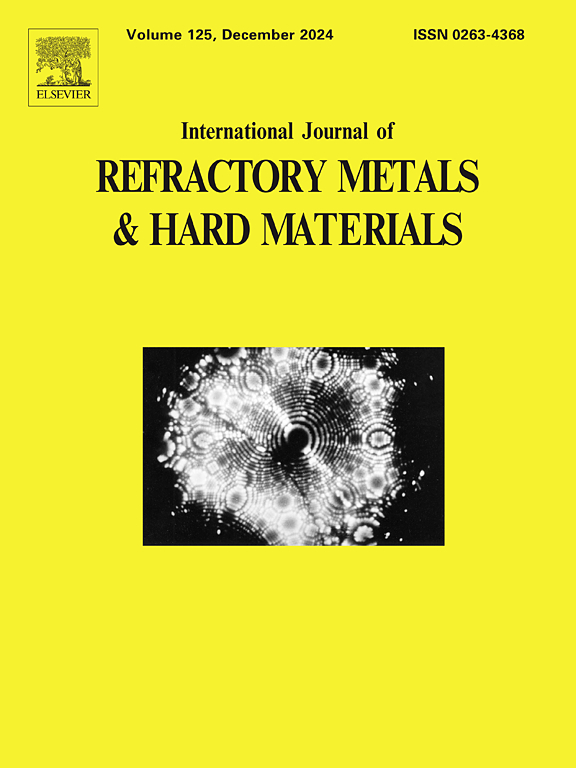Separation of cobalt and tungsten from grinding waste of cemented carbide by a mildly process of chloridizing roasting and water leaching combining
IF 4.6
2区 材料科学
Q2 MATERIALS SCIENCE, MULTIDISCIPLINARY
International Journal of Refractory Metals & Hard Materials
Pub Date : 2025-06-27
DOI:10.1016/j.ijrmhm.2025.107303
引用次数: 0
Abstract
Tungsten is primarily used to produce cemented carbide tools, generating substantial amounts of grinding waste of cemented carbide (GWCC) during machining. GWCC mainly comprises tungsten carbide (WC) and cobalt, which have significant economic value and are worth recovering. This work proposes a mildly recovery process involving chloridizing roasting and water leaching, introducing a novel transition and decomposition method for GWCC through chlorination roasting using CaCl2 as the chlorinating agent. Initially, Co and W in the GWCC are converted into CoCl2 and CaWO4, WO3 via chloridizing roasting. Subsequently, water leaching of the roasting product yields a CoCl2 solution and tungstate residue. Pure cobalt hydroxide precipitation is then obtained by adjusting the pH of the solution. The thermodynamic equilibrium of the WC–Co–CaCl2 system was first calculated, demonstrating that W and Co are entirely transformed into CaWO4 and CoCl2 above 400 °C with an initial chlorine-to‑cobalt ratio (nCl/nCo ratio) of 2.0. Detailed roasting experiments reveal that the maximum cobalt leaching efficiency was achieved at 600 °C. The nCl/nCo ratio significantly influences the conversion, and insufficient CaCl2 and low temperature lead to cobalt tungstate and cobalt chloride formation. Optimal roasting conditions were determined to be a temperature of 600 °C, a nCl/nCo ratio of 2.4:1, and a reaction time of 1 h, achieving a cobalt leaching efficiency of 94.32 %. Finally, pure cobalt hydroxide was precipitated, and the separated tungstate residue was a high-quality raw material used for tungsten smelting.

氯化焙烧-水浸结合温和工艺从硬质合金研磨废渣中分离钴钨
钨主要用于生产硬质合金刀具,在加工过程中会产生大量的硬质合金研磨废料。GWCC主要由碳化钨(WC)和钴组成,具有显著的经济价值,值得回收。本文提出了氯化焙烧+水浸温和回收工艺,介绍了一种以氯化钙为氯化剂,通过氯化焙烧对GWCC进行过渡分解的新方法。最初,GWCC中的Co和W通过氯化焙烧转化为CoCl2和CaWO4、WO3。随后,焙烧产物的水浸产生CoCl2溶液和钨酸盐残渣。通过调整溶液的pH值,可以得到纯氢氧化钴的沉淀。首先计算了WC-Co-CaCl2体系的热力学平衡,表明在400℃以上,初始氯钴比(nCl/nCo)为2.0时,W和Co完全转化为CaWO4和CoCl2。详细的焙烧实验表明,在600℃时钴浸出效率最高。nCl/nCo显著影响转化,CaCl2不足和低温导致钨酸钴和氯化钴的形成。焙烧温度为600℃,nCl/nCo比为2.4:1,反应时间为1 h,钴浸出率为94.32%。最后沉淀出纯净的氢氧化钴,分离出的钨酸盐渣是冶炼钨的优质原料。
本文章由计算机程序翻译,如有差异,请以英文原文为准。
求助全文
约1分钟内获得全文
求助全文
来源期刊
CiteScore
7.00
自引率
13.90%
发文量
236
审稿时长
35 days
期刊介绍:
The International Journal of Refractory Metals and Hard Materials (IJRMHM) publishes original research articles concerned with all aspects of refractory metals and hard materials. Refractory metals are defined as metals with melting points higher than 1800 °C. These are tungsten, molybdenum, chromium, tantalum, niobium, hafnium, and rhenium, as well as many compounds and alloys based thereupon. Hard materials that are included in the scope of this journal are defined as materials with hardness values higher than 1000 kg/mm2, primarily intended for applications as manufacturing tools or wear resistant components in mechanical systems. Thus they encompass carbides, nitrides and borides of metals, and related compounds. A special focus of this journal is put on the family of hardmetals, which is also known as cemented tungsten carbide, and cermets which are based on titanium carbide and carbonitrides with or without a metal binder. Ceramics and superhard materials including diamond and cubic boron nitride may also be accepted provided the subject material is presented as hard materials as defined above.

 求助内容:
求助内容: 应助结果提醒方式:
应助结果提醒方式:


